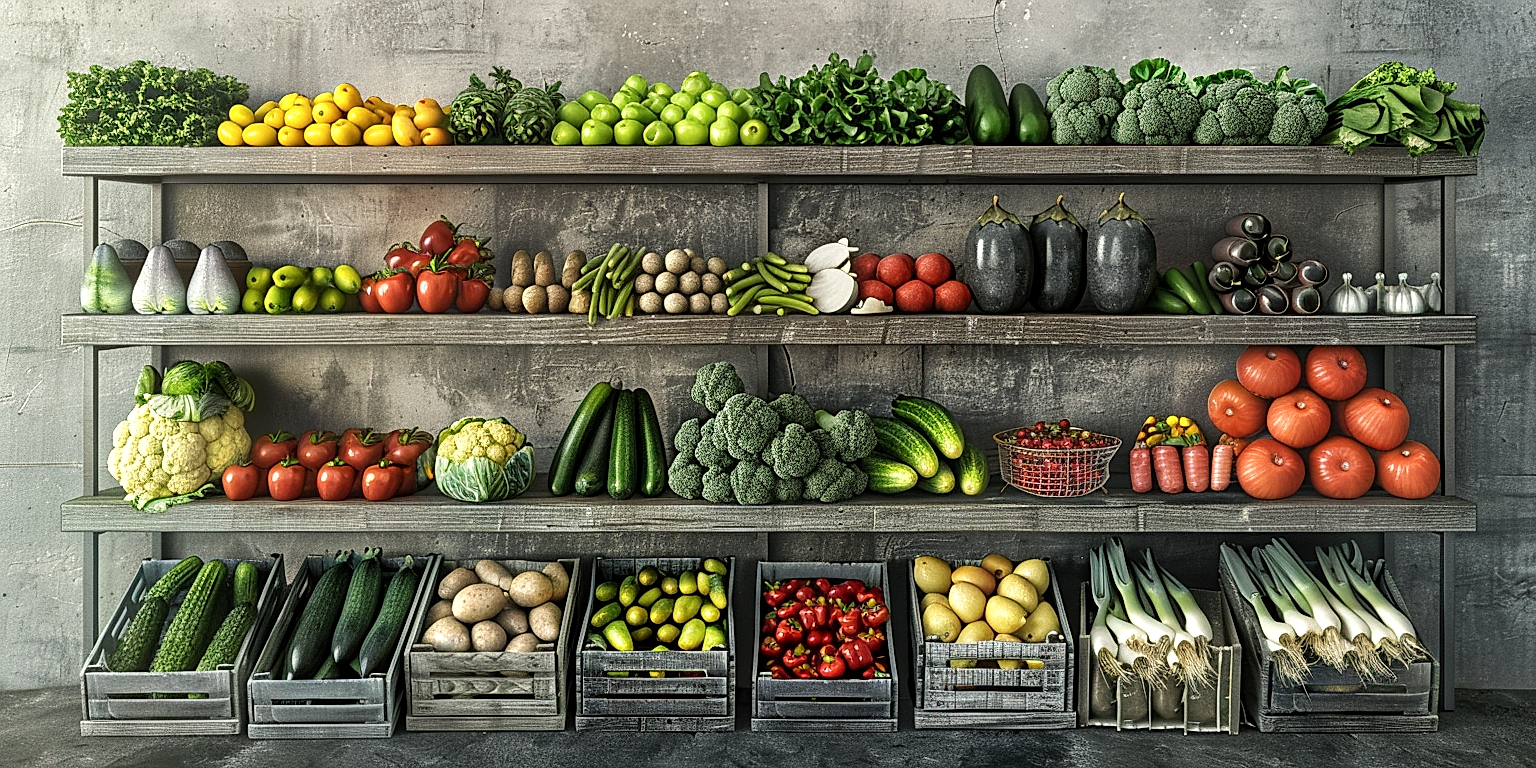As the retail industry continues to evolve, the focus on strategic merchandising to align with consumer shopping trends has never been more critical.
In the realm of produce, this strategy is acutely vital.
Retailer success often rides on their ability to adapt their merchandising techniques to capitalize on seasonal changes.
The ability to effectively merchandise in line with the ebb and flow of seasonal produce can be a decisive factor in a retailer’s prosperity.
This approach provides several benefits, some obvious and others less so.
Let’s delve into these advantages in this exploration.
Contents
Benefits Of Seasonal Merchandising In Produce Retail
1. Promotes Diversity of Fresh, Locally-Grown Produce.
Seasonal merchandising in produce retail is a strategy built on promoting fresh, locally-grown produce.
The direct consequence is encouraging and backing the diversity of the local crop production.
By stocking and creating displays of fruits and vegetables that are in season, retailers can showcase a wider variety of options than merely displaying popular, more commonly purchased items.
This quote elaborates upon the community-driven power of such a strategy, “Seasonal merchandising shines a spotlight on an often overlooked variety of local produce, and allows customers to discover new options.”
When retailers demonstrate a commitment to local farmers by purchasing and promoting their produce, it encourages the growth and diversity of local agriculture.
Supporting this diversity not only benefits the retailer through sales of unique products but also benefits the local farmers who can continue to grow a wider range of crops.
In turn, the local community also benefits from the opportunity to try new foods and seasonal offerings they might otherwise overlook.
Retailers can further promote and support this diversity by providing information about the farmers, their practices, and the benefits of choosing local, seasonal produce.
This can be achieved through point-of-sale brochures, information leaflets, or even on-site tastings to stimulate customer interest and awareness.
Through seasonal merchandising, an ever-changing array of local produce can be brought to the forefront, enticing customers with a fresh selection each season.
Emphasizing diversity also helps businesses stand out and strengthens their relationship with local farmers and the community at large.
A seasonal approach to merchandising makes a compelling reason for consumers to return to the store frequently, knowing they will find something different each time.
This diversity promotion also enables customers to directly contribute to the sustainability of local agriculture, adding an extra level of value to their experience.
To foster better customer engagement, retailers may consider implementing initiatives such as loyalty programs, discounts for buying seasonal produce or educational sessions on how to use new and diverse produce.
In essence, by significantly focusing on fresh, local and diverse produce, seasonal merchandising taps into a variety of benefits, from economic to cultural, reinforcing the central role of agriculture in our daily lives.
2. Increases Customer Interest and Engagement
Seasonal merchandising in produce retail offers an enticing diversity in goods for shoppers.
This practice revolves around offering different fruits and vegetables that are in season at a particular point in time.
For instance, during summer, a customer could find a wide array of juicy fruits such as cherries, peaches, and watermelons.
Conversely, during the winter, produce sections will hold a variety of root vegetables and citrus fruits that are known for their winter growth.
As such, consumers are presented with a new and refreshing variety every couple of months that creates a continual sense of novelty and excitement.
This strategy has a twofold effect; firstly it heightens the anticipation of clients who look forward to their favorite seasonal fruits or vegetables thereby maximizing the chances of return visits.
Secondly, it stimulates shoppers’ curiosity and interest since they are likely to encounter different sorts of produce every time they visit.
This element of novelty can induce impulse purchases which would not occur if the selection of produce was predictable or stagnant.
Moreover, the rotation of seasonal products offers learning opportunities for consumers.
They could, for instance, learn about the nutritional benefits or discover new methods of cooking certain produce which can enhance their overall shopping experience.
In essence, seasonal merchandising incorporates an aspect of retailtainment, wherein shopping is not just a mundane activity but an enjoyable and informative experience.
It forges a connection between the customer, the food they eat, and the changing seasons.
This interaction not only leads to heightened customer interest but also provides a platform for increased engagement.
Consequently, promoting seasonal products at a produce retail store is a highly effective strategy for captivating customers attention.
It creates a unique shopping environment that is dynamic, interesting and ultimately leads to increased customer engagement.
Therefore, infusing seasonal merchandising in produce retail plays a key role in customer retention and overall business profitability and is a strategy that retailers should keenly consider.
3. Encourages Healthier, Seasonal Eating Habits
One significant benefit of seasonal merchandising in produce retail is how it encourages healthier, seasonal eating habits.
As a consumer, having a diverse range of fresh, locally-sourced produce readily available promotes the consumption of a plethora of nutrients and vitamins.
By capitalizing on the natural cycles of growth and harvest, seasonal merchandising ensures that customers are getting the purest, most nutrient-rich produce possible.
Produce that is consumed in its appropriate season, and harvested locally, means it is less likely to be laden with preservatives and artificial enhancers to “fake” a fresh appearance or taste.
In contrast to the constant availability of the same produce year-round, a rotation of seasonally-culled fruits and vegetables can motivate customers to try new foods they may not have considered otherwise.
The variety implicit in seasonal merchandising can encourage experimentation with new recipes and flavors, adding to the allure of healthier food choices.
It essentially encourages a natural way of eating that is more synchronized with our bodies’ nutritional needs per seasonal period.
The regularly rotating range of produce can keep customers excited about each new ‘food season’, promoting anticipation and engagement with the retailer’s offerings.
Moreover, information disseminated through in-store promotion or online platforms about eating seasonally can facilitate a more educated customer base, who begin to appreciate not just the taste, but the health benefits of such produce as well.
Eating seasonally, embedded within the context of sustainable produce consumption, also offers valuable lessons in food waste reduction, as purchasing only what is needed for a season can lead to fewer instances of spoilage and waste.
This approach to retail not only benefits the customer’s body but it also contributes to a healthier planet, by lowering the environmental footprint of off-season transport and unnatural farming practices.
Therefore, seasonal merchandising can ultimately kickstart a change in a consumer’s eating habits – a move towards a more responsible and healthy approach to food consumption.
From a business perspective, promoting healthier, seasonal produce can reflect positively on the retailer, elevating their brand as one that values not only profit but also customer health and ecological conservation.
Thus, the intertwined relationship between seasonal merchandising and healthier eating habits holds power in transforming both individual consumption patterns and broader retail practices, making it an inseparable part of any successful produce retail strategy.
4. Boosts Sales and Profitability
When it comes to understanding the impact of seasonal merchandising on a produce retail business, boosting sales and profitability emerges as a paramount benefit.
Seasonal merchandising has the potential to drive consumer interest and demand for fresh, local, and seasonal products, consequently leading to an increase in sales.
This strategy aligns with consumer preferences for fresh and locally-sourced produce over imported options which are often associated with higher prices and lower freshness.
By employing or enhancing seasonal merchandising in their retail spaces, businesses can effectively increase their sales volume while simultaneously promoting healthier and more sustainable consumer eating habits.
Additionally, merchandising with an emphasis on seasonality creates a dynamic and ever-changing retail environment that triggers curiosity and nurtures a sense of discovery among shoppers, which in turn, magnetizes repeated foot traffic and impulse purchases.
Another monetary advantage of this approach lies in the lower cost associated with purchasing local and in-season goods, which significantly reduces import expenses and the costs related to long-haul transportation and storage of produce.
The savings from these reduced costs can be utilized to further improve other aspects of the business, such as marketing, employee training, or store aesthetics, which indirectly boost sales and profitability.
Seasonal merchandising also fortifies a business’s brand image as a promoter of local farmers and sustainable agriculture, which can influence consumer behaviour and buying decisions in a way that is profitable for the business.
Stores that successfully implement effective seasonal merchandising strategies often enjoy a loyal customer base, fostered by providing access to a diverse offering of fresh and unique seasonal products.
This loyalty translates into consistent, injecting a vitality into the store’s financial health.
Furthermore, stronger sales numbers and profitability afford businesses the flexibility and ability to experiment with new products, diversify their range, or introduce other innovative, customer-focused initiatives.
The adoption of seasonal merchandising as a business strategy is a win-win for both retailers and consumers, as it not only benefits the business itself but also supports the local farming community and encourages healthier, sustainable eating habits among consumers.
In essence, seasonal merchandising in produce retail represents an opportunity for businesses to sustainably grow their revenues, profit margins, and overall market prominence while actively contributing to the betterment of society.
5. Supports Local Farmers and Economy
One often overlooked but significant advantage of seasonal merchandising in produce retail is its capacity to support local farmers and the local economy.
By prioritizing seasonal produce, retailers can more frequently partner with local agricultural businesses, opening up a new, more sustainable and mutually beneficial trade relationship.
Such a shift in focus from an international to a local supply chain not only reduces carbon footprint but also aids local farmers in marketing their produce effectively.
The production of out-of-season produce often involves complex and energy-intensive farming practices, many of which can be bypassed with a focus on seasonal fruits and vegetables.
By stocking local, seasonal produce, retailers give local farmers a much needed platform to sell their harvest, thereby fostering their sustainability and growth.
This understandably has a positive ripple effect on the local economy – the money spent on local produce stays within the community, supporting other local businesses and boosting the area’s economy.
Furthermore, the promotion of local agriculture creates job opportunities, adding another layer of economic benefit.
By sourcing produce locally, retailers can also ensure fresher, higher quality produce for their customers – a factor which can certainly boost customer satisfaction and loyalty.
Store owners who take the time to build relationships with farmers and understand their crop cycles can help educate customers on the benefits of eating seasonally and locally, further stimulating demand for these products.
The visibility of local produce in stores can also raise awareness of local farming efforts, effectively spotlighting the importance and value of supporting this sector.
Choosing to fill stores with local, seasonal produce is not just a good business move – it is an ethical one that supports a more sustainable and self-sufficient community.
Undoubtedly, preferences have been shifting towards the ‘home-grown’ and ‘organic’, which local, seasonal produce fits perfectly into – another reason why retailers should look at this strategy more seriously.
Thus, beyond just the economic gains, seasonal merchandising in produce retail has the potential to create a positive change in societal consumption patterns, moving towards more responsible and conscious choices.
Seasonal merchandising, therefore, provides an integrated solution to boosting business while supporting local agriculture and economy.
Overall, the numerous ways in which seasonal merchandising in produce retail benefits not just the store, but the local farmers and economy, makes it a clear choice for sustainable, future-ready retail strategies.
The Bottom Line
Taking all these factors into account, fostering an appreciation for fresh, locally-grown produce not only enhances the diversity of our plates, but also furthers customer involvement.
It cultivates healthier eating practices in rhythm with the seasons and is a powerful catalyst for boosting sales and profitability.
Moreover, it provides essential support to local farming communities and drives the local economy.
It can be said without reservation that promoting locally grown produce represents a holistic and sustainable approach to food consumption that yields multiple benefits for all stakeholders.




